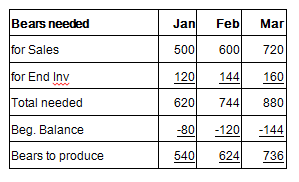Barrington Bears has developed the following sales forecasts for the next few months. January 500, February 600, March 720, April 800 and May 770. BB has 80 bears on hand on Dec. 31. Normal ending inventory policy is to hold 20% of next month’s sales. Each bear needs .8 yards of fabric and two pounds of stuffing. Fabric is budgeted to cost $15 per yard and stuffing $4 per pound. Direct labor is paid $18 per hour. Each bear takes 40 minutes to hand-finish. Variable overheads total $21 per direct labor hour. Fixed overheads amount to $25,000 per month. Eighty yards of fabric and 100 pounds of stuffing were in stock at year-end. Ten percent and 25% of next month’s stuffing and fabric needs respectively are planned for raw materials ending inventory each month.
How many bears must be produced in February?
A. 600
B. 540
C. 624
D. 744
E. None of the above
C. 624

You might also like to view...
Using an ownership team keeps the implementation process on track even when some members of the team are away for extended periods because of business trips, training programs, illness, or vacations
Indicate whether the statement is true or false
Gains and losses on the purchase and resale of treasury stock may be reflected only in
a. paid-in capital accounts. b. paid-in capital and retained earnings accounts. c. income, paid-in capital, and retaining earnings accounts. d. income and paid-in capital accounts. e. None of these answer choices is correct.
Expectancy theory argues that people answer questions about whether they will be rewarded
a. in all or nothing terms b. in overly optimistic ways c. in overly pessimistic ways d. with probability estimates
Which of the following is NOT a part of the safe harbor provision for forward-looking statements under the 1934 Act?
a. A statement containing a projection of revenues, income, or other financial items. b. A statement of the plans and objectives of management for future operations. c. A statement of future economic performance. d. A statement in a financial statement prepared in accordance with generally accepted accounting principles.